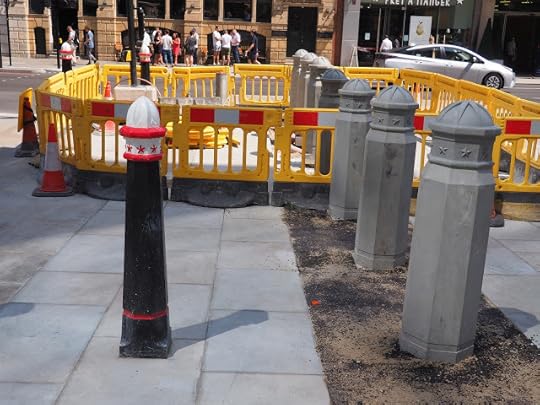Geoff Nicholson's Blog, page 4
May 6, 2024
THE FUNERARY FLANEUR
 Photo from the Daily Telegraph's obituary, courtesy the Bax family
Photo from the Daily Telegraph's obituary, courtesy the Bax familyLast week I went to the funeral of Dr Martin Bax, best known in my circle as the editor of the literary magazine Ambit, though I was always well aware that he had a parallel life as a pediatrician with an international reputation. He was one of the first people ever to publish my writing, I worked for Ambit as his prose editor, and in due course we became very good friends. This was the Ambit office:

I had no idea how I was going to feel during the funeral itself, though I knew it would be a difficult day one way or another, and it was some distance from where I live. Getting there would involve a train, Tube, and bus ride so I gave myself all the time in the world, which also meant that there would be time to do some walking, wandering, looking, and thinking about things that might or might not relate to Martin and his departure.
At Liverpool Street station I took a small detour to look at Richard Serra’s giant sculpture Fulcrum, which was installed in 1987, a time when my relationship with Martin was in its very early stages. Fulcrum is a strange, magnificent and uncompromising thing, a visitor from a different dimension yet strangely at home in its environment, officially part of the Broadgate Development. In fact the work seems to be so at home that the people walking by, workers, commuters, builders, pay it next to no attention.
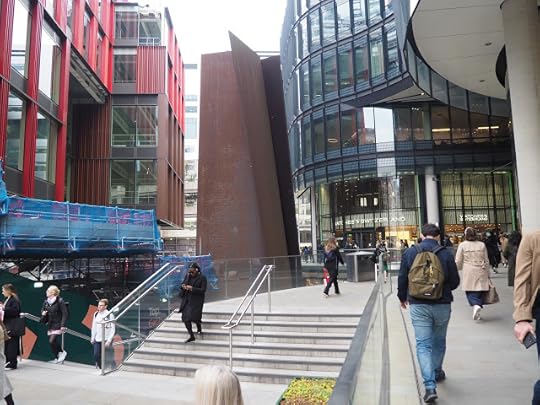
I look the tube to East Finchley and decided to walk up through the suburban streets to St Marylebone Crematorium where Martin’s funeral was to be held. Of course just because you’re in a new place or on the way to an important event, doesn’t mean you forget all your old quotidian interests and mild obsessions, which in my own case includes metal buildings and in East End Rd I saw this fine example, a chapel I suppose, of the kind I’ve often seen in Wales.

At that point I hopped on a bus so that I arrived at the crematorium early enough to have a short walk in the memorial garden, a neatly organized set of beds with low, trimmed hedges.

I thought these were box plants and I happen to know that the world’s box population is being systematically devastated and destroyed by the box tree moth, but the website says the hedges are privet. I hope they’re right.
After the funeral and a small lunch, a few of us walked down to Highgate Cemetery where Martin and his late wife Judy will eventually have a memorial. For now we wandering and looked at graves of the famous, Eric Hobsbawm, Bert Jansch and George Eliot, among them – George Eliot even had an obelisk, and you know probably know that obelisks are among my more major obsessions.
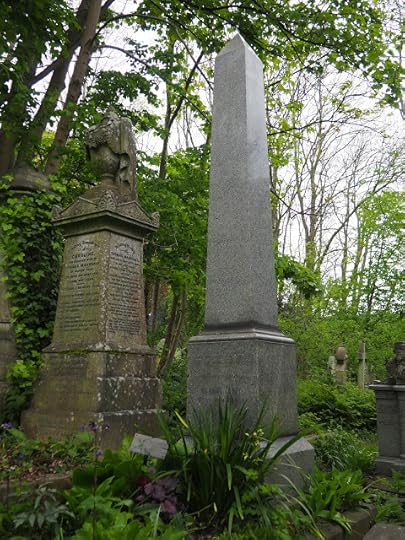
The Highgate cemetery provides many fine examples.

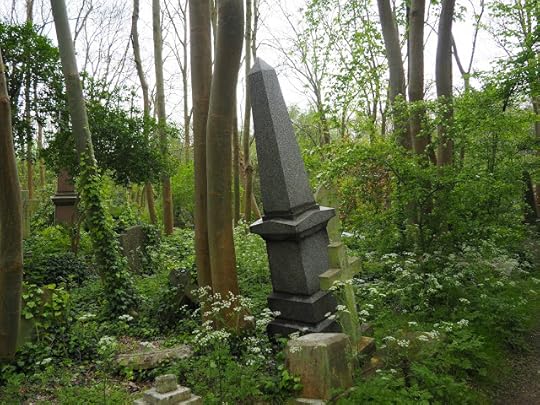
The cemetery is also, perhaps primarily, famous as the resting place of Karl Marx, and you’ve no doubt seen this:
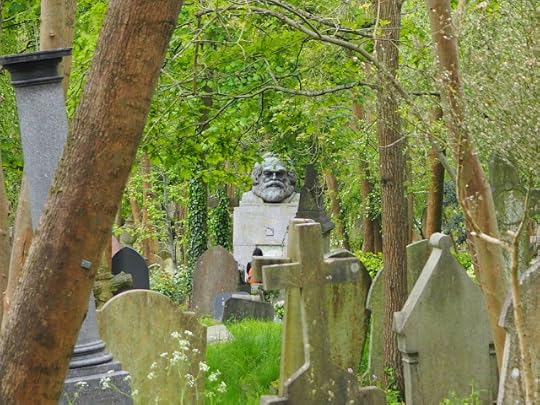
I had assumed this was where the great man was buried, but no, this is only a memorial: Marx and his wife are actually buried nearby in this far more modest grave.
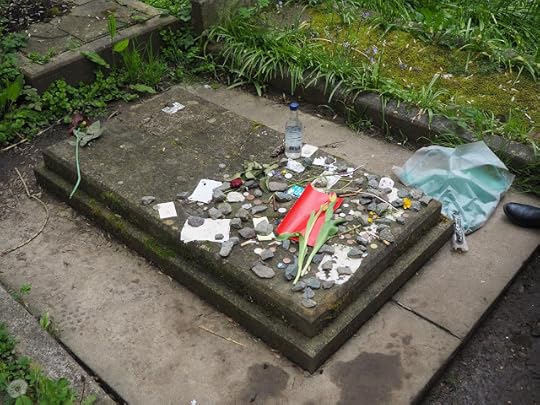
There was also a short detour through Wicklow Park. There seemed to be something poignant, poetic and symbolic about this meandering serpentine mown path, but perhaps, after a funeral all things seem poignant and poetic and symbolic.
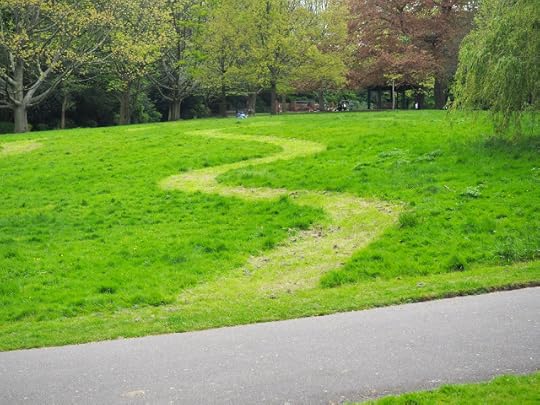
April 26, 2024
WALKING WITH WORDS

I remember when I was a kid, when I was first learning to read, there was an occasion when I was walking with my dad, and we were in a part of Sheffield by the steel works, and I looked up at a big yellow sign, full of text, black on yellow and advertising Hillfoot Steel as I remember, and I stared at all those words and said to my dad, ‘I’m never going to be able to read all that.’ He did his best to put my mind at rest and said I’d learn soon enough. And I suppose he was right.

One way or another, I’ve made my life out of words, and today when I walk through a city, I love the fact that I’m surrounded, beset, by language, by signs, by names, by advertising, by instructions, by warnings, by prohibitions, telling me what I should and shouldn’t do. Of course there are also graffiti but I think that gets enough publicity.


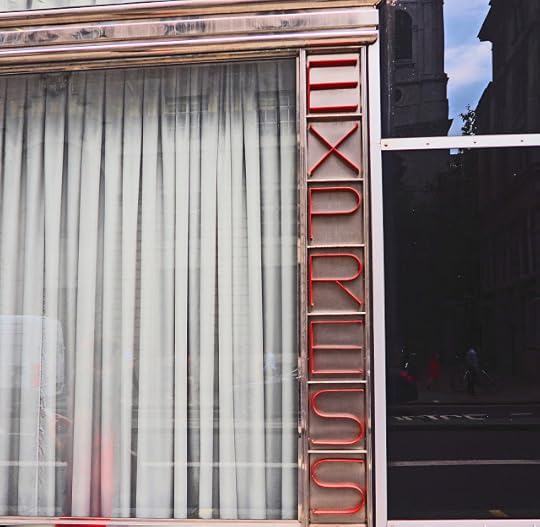
Some of the words may be on street signs, for instance, though it seems to me there are rarely enough of those. Here's an exception:
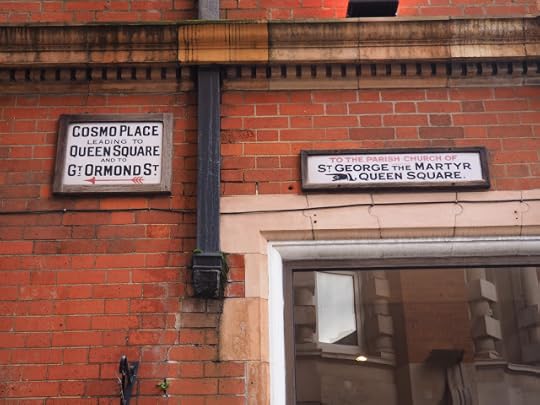
Some of these words express opinions, enthusiasms, philosophies, belief systems, though inevitably most of this isn’t very nuanced.


Some of it is downright inscrutable, which is perhaps to say that it’s not intended for everyone, such as me.
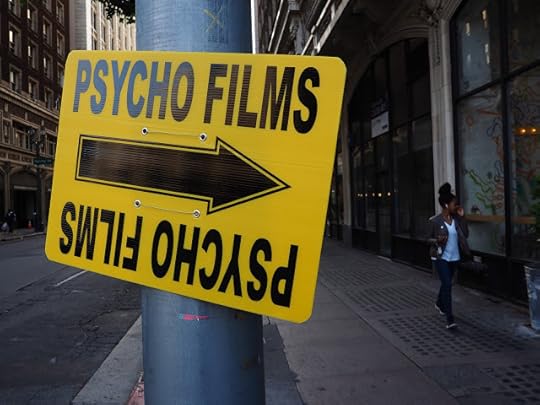
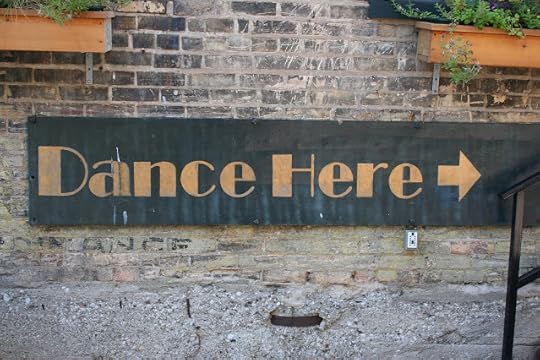
Some of it, of course, is only directed at drivers.

As a walker I particular enjoy those messages that are directed specifically at pedestrians, some of which might make you think that walking is a hazardous, risky and confusing business. And you know, sometimes it really is.
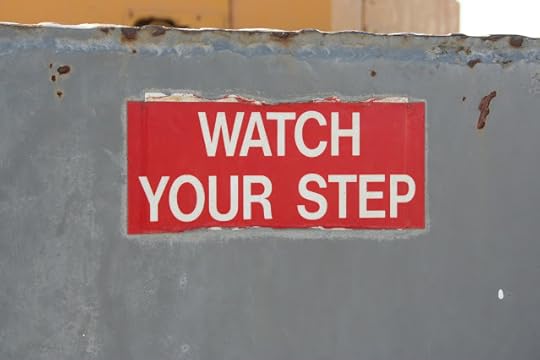

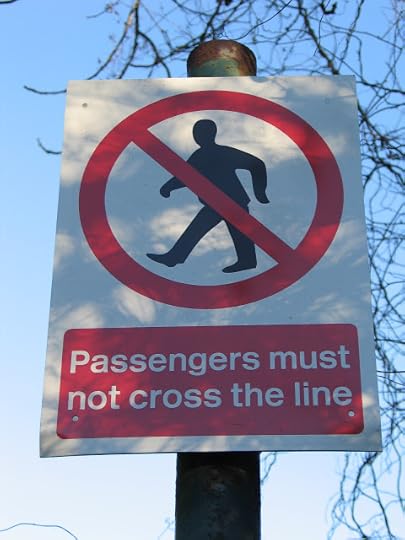
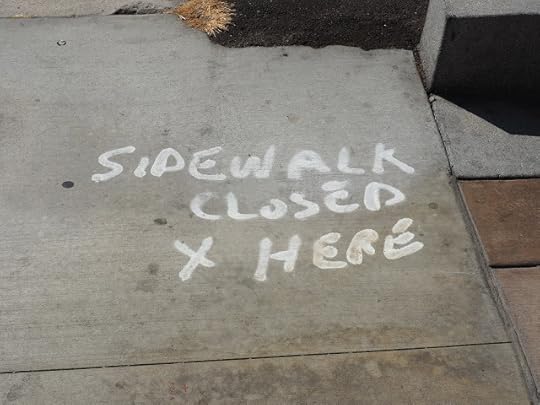
April 17, 2024
EVERYBODY WALKS IN LA.

‘To perceive differences within the homogenous elements of the cultivated and inhabited urban landscape, I eschewed the common means of transportation, the automobile, and explored the entire area on foot … I closely engaged with people of different ages, occupations, social positions, and origins, I gathered oral narratives from people who seemed reliable and whom I encountered on my walks in different neighborhoods.’
These are the words of Anton Wagner, writing about his explorations of Los Angeles in the 1930s.
Until about three days ago I would have said I’d never heard of Anton Wagner. He was a German geographer, who as a result of his LA explorations published a book in 1935, titled Los Angeles: Werden, Leben und Gestalt der Zweimillionenstadt in Südkalifornien, only now translated into English as Los Angeles: The Development, Life, and Structure of the City of Two Million in Southern California.
I’ve only heard of Wagner now because I read about the book in the Los Angeles Review of Architecture, in a piece by Namik Mackic. The book’s published by the Getty Research Institute and It costs 60 quid in paperback, so reviews are as close as I’m likely to get. It looks like this:
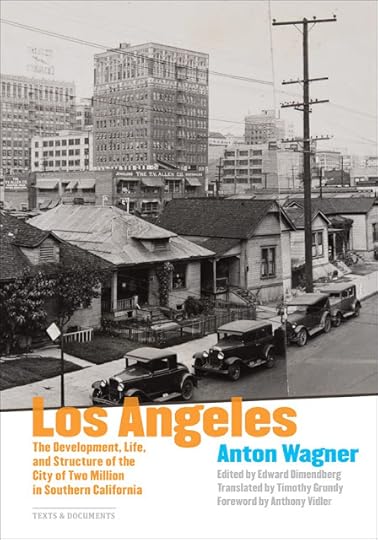
The publisher’s blurb says ‘Although widely reviewed upon its initial publication, his (Wagner’s) book was largely forgotten until reintroduced by architectural historian Reyner Banham in his 1971 classic Los Angeles: The Architecture of Four Ecologies.’ This was news to me, and I like to think I know that book reasonably well.
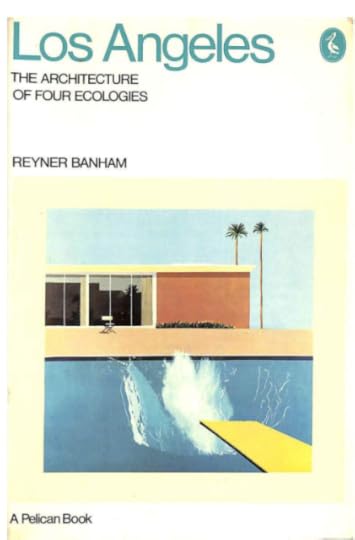
So I dug out my copy, the Pelican edition, and there’s one citation for Anton Wagner in the index – page 230 - but when you look at that page his name doesn’t appear. Only by going to Banham’s last chapter titled ‘Towards A Drive-In Bibliography’ will you find a mention of Wagner, which reads in part, ‘The only comprehensive view of Los Angeles as a built environment … The result is one of the few works of urban exploration that comes within sight of Rasmussen’s London: the Unique City, ’ – a book I’m pretty sure I own a copy of, though I’m damned if I can find it at the moment.
Anton Wagner, it seems, was something of a photographer and the California Historical Society has digitised a large number of his photographs. He doesn’t appear in any of the histories of photography I’ve consulted, so I don’t know what kind of methodology or indeed camera he used, but the pictures are terrific. They show a city that’s occasionally familiar but mostly alien, a city coming into being. Many of the photographs take a broad, distant, sometimes god-like look at Los Angeles, long and broad views, very few of them taken from ground level.
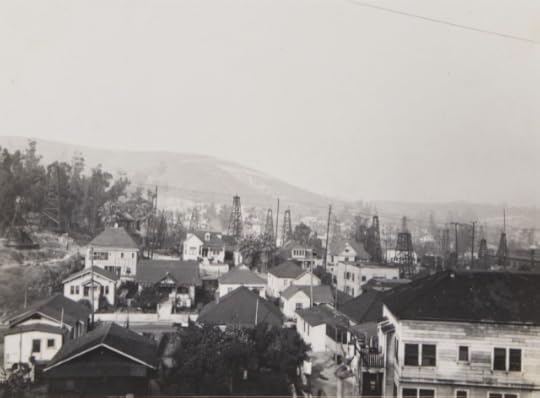
Now, if you’re a walker in Los Angeles, as I was for 15 years or so, you tend to meet other walkers, but I’m not sure that Wagner did. There are remarkably few people in the pictures, even fewer people you can easily identify as walkers, which make the few who appear all the more intriguing, such as these people you can just about make out walking in, or through, Pershing Square.
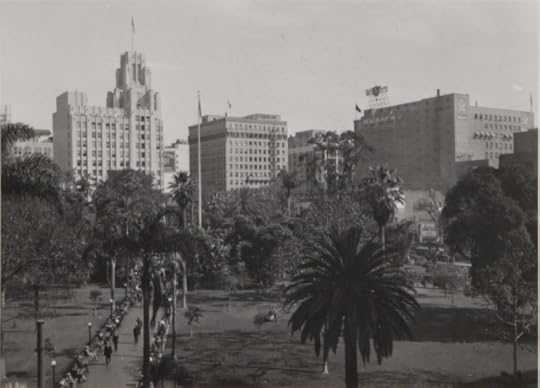
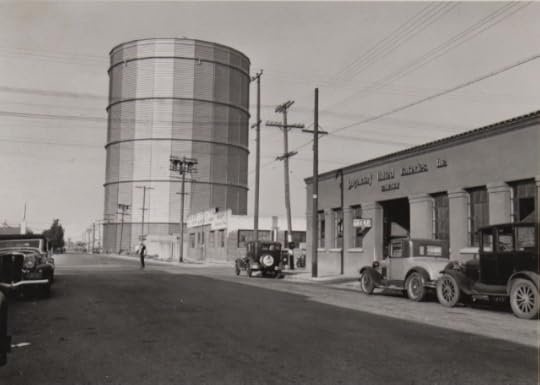
The caption reads 'Looking north on South Andrews Place from south of West 62nd Street.' And thanks to Google we can see what it looks like now. Still very quiet, in a different way, and not a single pedestrian in sight.

ldest oil derricks, Mexican neighborhood
April 10, 2024
CAT WALKING
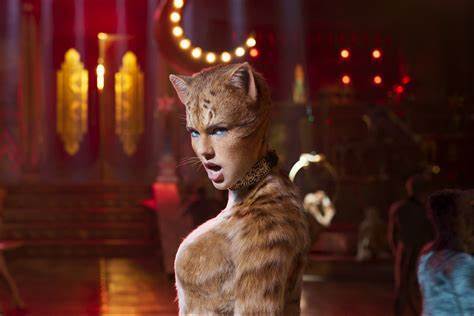
More often than not, when I look out of my front window into the suburban glories of Essex I see somebody walking their dog, sometimes two dogs. It’s often a slow process because indulgent dog owners stop so that their canine pals can have a good sniff at whatever it is dogs like to sniff. And of course it’s made slower still if the owners have to pick up the poop excreted by the hound. Personally that’s not my idea of a good walk but then I’m more of a cat person.
However, according to a story that appeared in the newspapers recently, there’s currently a trend for people to walk their cats on leads. The Times headline read ‘Going walkies is cool for cats too as more peripatetic pets take the lead.’ They really worked hard on that one.
This trend doesn’t come as a complete surprise to me. I once met the fellow in the picture below, named Steve, whose cat is named Boris the Bold:

And of course there’s good old Cary Grant with his:

The Times article did involve some discussion about whether or not it was cruel and unusual to walk a cat on a lead. The RSPCA ‘warned that some cats may become frightened on leads.’ Implying of course that some may not.
However, for me, the most surprising line in the article ran as follows, ‘a London-based cat behaviourist said that if it suited a cat’s temperament then walking them on a lead could be a great way to bond with a pet and allow them to get fresh air and explore safely.’ I had no idea there was any such thing as a cat behaviourist, but then I’m not that much of a cat person. And I suppose the corollary of this behavourist wisdom is that if walking on a leash doesn’tsuit a cat’s temperament then he or she will let you know very quickly, possibly by clawing your eyes out.

April 3, 2024
WALKING WITH BOLLARDS
When I first got back to England after 15 years or so living in Los Angeles, I rented a small flat in London and walked the streets noticing things, and sometimes taking photographs. For some of us, walking and noticing are inseparable: that’s what walking is for.
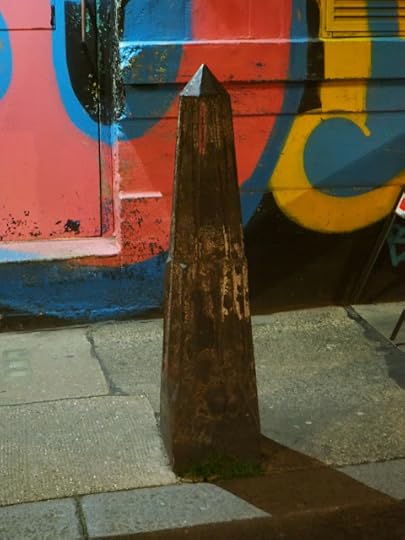
And among the things I noticed and photographed in London were bollards. Now these are surely not a uniquely British thing: it seems that people all over the world would want to use something or other to block streets and traffic, but London seemed to have more than I’d ever seen anywhere in the States, though it seems that the American usage generally refers to posts on the side of a river or wharf, the things that boats are tied up to. I stand to be corrected on this.
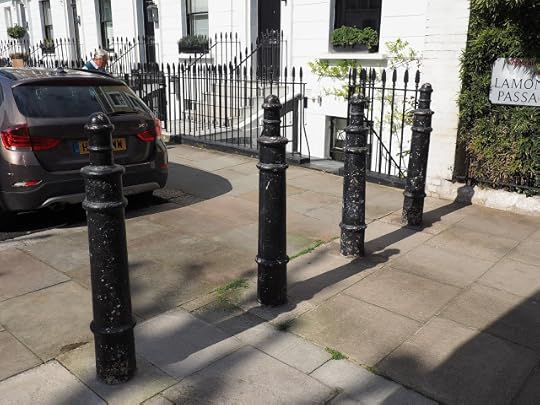
After a while, having acclimatized to London and England, I sort of forgot about bollards – well, I didn’t really forget, I just got distracted by noticing other things - though not before the inamorata had given me the fine print seen beside me in this picture (thanks young Caroline). It’s attributed to Matt Brown/Londonist, and the highlight of the print is the J.G. Bollard.
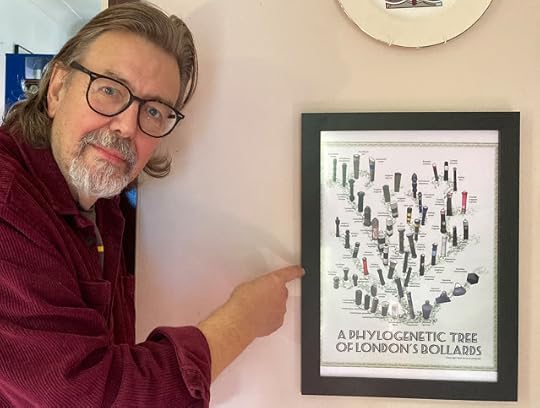
But lately I’ve been reading Edwin Heathcote’s On the Street: In-Between Architecture, a book about street furniture. It’s full of great pictures, many taken by EH on his walking travels, along with photographs by some of the greats – Henri Cartier-Bresson, Helen Leavitt, Robert Frank, Vivian Maier, Eugene Atget and others.
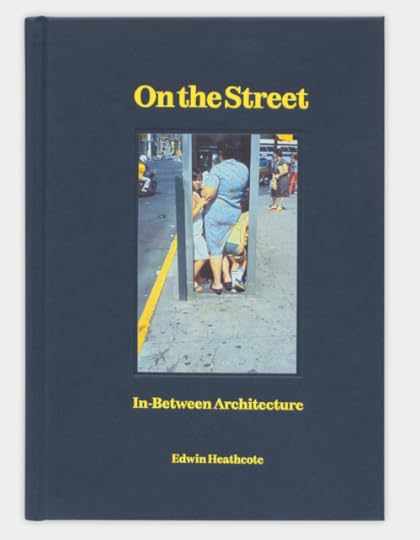
Heathcote is a great noticer and his noticing often overlaps with my own minor obsessions - public benches, discarded gloves, manhole covers, Thomassons, and as it happens, bollards. He confirms that bollards are indeed international and cites examples in Rome, Siena and Amsterdam, says that they’re ‘the ultimate symbol of defence and defiance’ and concludes that ‘the future is absolute bollards.’
Suddenly I started to find bollards interesting again. Even so I felt they were a big city thing, but finding myself in Mistley, a somewhat picturesque village on the Stour Estuary in Essex, though one with a maritime and light industrial element, they seemed to be everywhere.
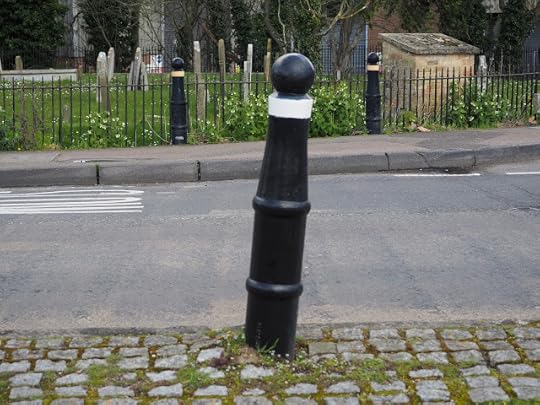


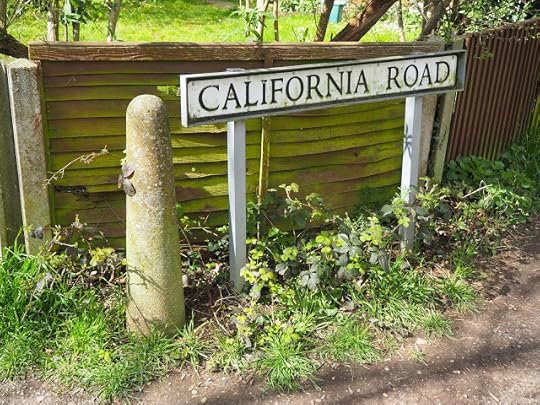
And then, on Mistley Quay - which is a highly contested place – we can talk about it elsewhere – there were these bad boys:


A local information sign referred to them as bollards, ie the things that boats are tied up to as per the American usage. So much to learn, so much still to notice.
March 23, 2024
HOBBLING WITH OBELISKS
As I’ve said before, I accept that not everybody is as moved by obelisks as I am. But once you start looking for them they pop up all over the place – you’ll be walking along and boom – there it is, often in the least likely place.
Let’s say, for example, one afternoon you’re ambling in Mistley in Essex, just up the road from where I live, and you see a garden containing a tall, green topiary obelisk, well you’re going to be impressed by that: but wait.
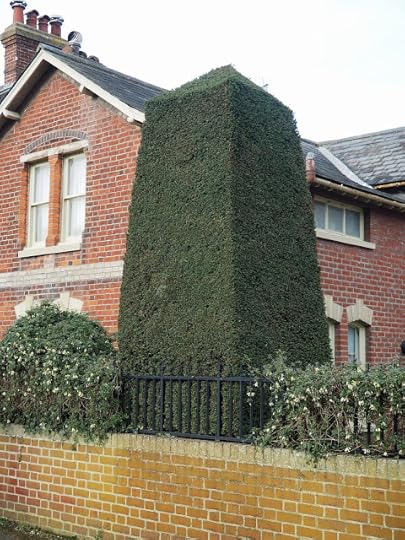
Then you walk a little further up the street and you see that behind the live, growing obelisk there’s a wooden garden obelisk, as they’re called. These aren’t really obelisks in the truest sense – they lack the all-important pyramidion – but they’re still a good thing.

And then say, one night having been to a lecture by Todd Longstaffe-Gowan on the lost gardens of London, and you’re walking along the Albert Embankment between Lambeth and Vauxhall, and you see this thing tucked away behind a hoarding. I took a picture, not sure what I was taking a photograph of. A spot of Photoshopping helped a little, but only a little.
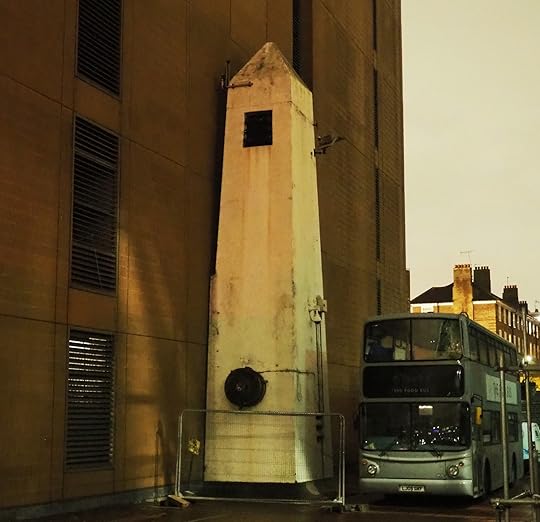
Some online research reveals that it’s standing tight beside the headquarters of the International Maritime Organisation:
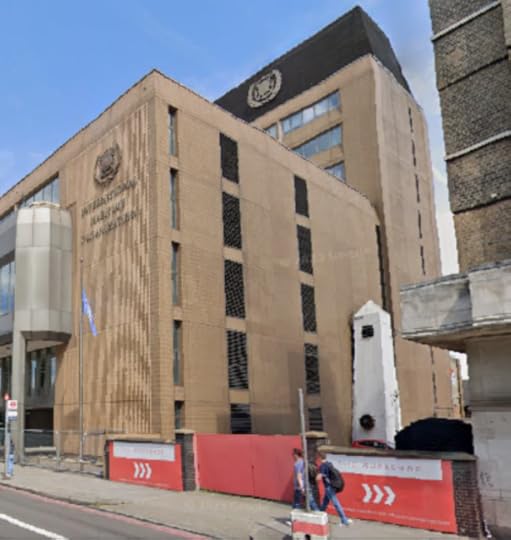
and further messing about with Google streetview indicates it’s actually in a car park.
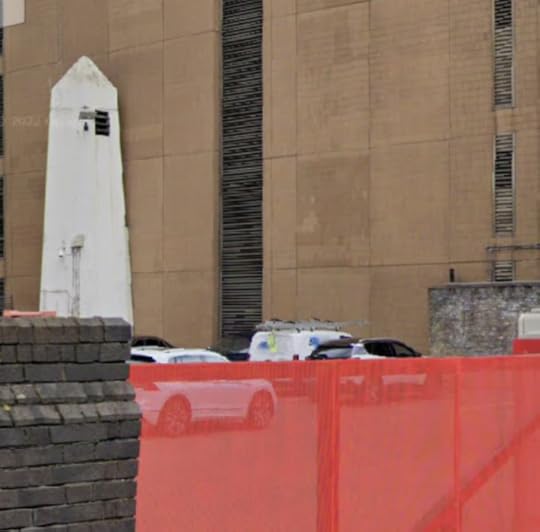
More than that I don’t know, but I’m inclined to think it must be some kind of ventilation duct, most likely for the Tube, like this one in honour of George Dance the Younger, who laid out the Finsbury Estate in the last quarter of the eighteenth century.

Frankly it seems to me that if you’re going to have a ventilation duct for a subterranean railway, then why wouldn’t you have it in the shape of an obelisk?
And then, and I don’t want you to think my life is glamorous or colourful or anything, but last week I was given a personal tour of the Charles Jencks’ Cosmic House (currently under refurbishment). My guide was Edwin Heathcote, the architecture and design writer, and also ‘The Keeper of Meaning’ at the house – a job title that’s hard to improve on. (I get to call him Eddie).
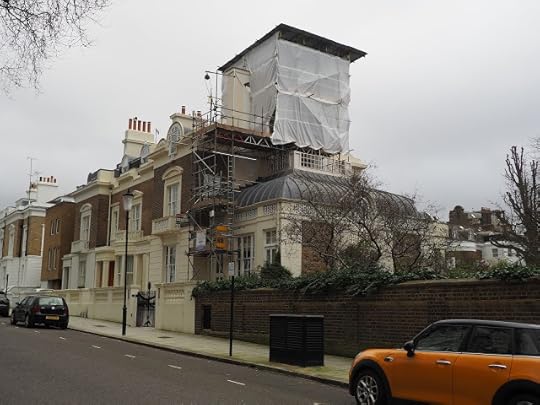
And as we walked through the postmodern and indeed cosmic wonders of the house, there were obelisks galore, small ones, decorative objects, many of which if I understood Mr. Heathcote correctly, were bought by Jencks on souvenir stalls around the pyramids in Cairo.
There was also this marvelous and unusual tableau, someone working at a computer while bracketed by obelisks. I may have to find a way of doing that myself.
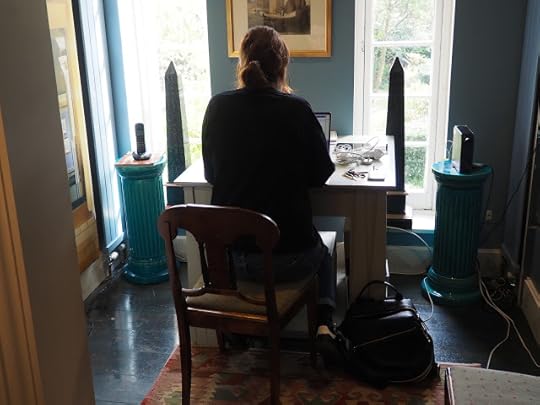
March 20, 2024
WALKING IN FOOTSTEPS
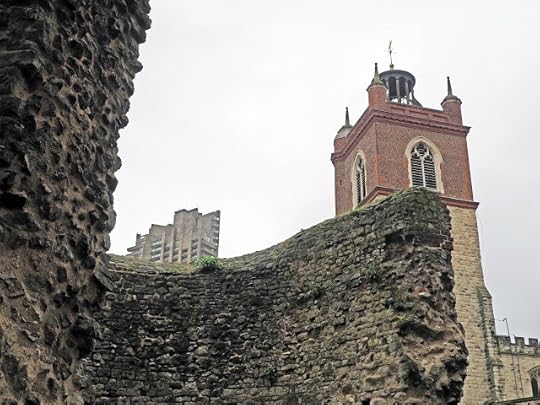
On Sunday I went on a guided walk led by my pal Jen Pedler, with Footsteps of London, a walk based on Rose Macaulay’s book The World my Wilderness, following in the footsteps of the book’s heroine Barbary. This is Jen keeping her anonymity:

The novel, published in 1950, is set in London shortly after the Second World War, mostly around the City of London where St Paul’s Cathedral remained intact after the Blitz even as much of the area around it was in ruins. Then the ruins became a wilderness, and in that wilderness a certain kind of life flourished.
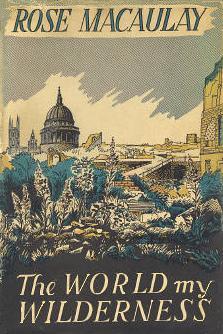
Barbary is sent from France to Londo
n by her posh Bohemian mother Helen to study art at the Slade. She paints and sells postcards of ruined London, and she meets various colourful and dodgy working class types.
I’ve read critics who say that the name Barbary is supposed to raise questions about what is and isn’t barbarous, and I don’t doubt that’s true, but personally I thought of Barbary pirates, because there is something piratical and lawless about the characters in the novel, even if unlike the actual Barbary pirates they’re not slave traders.
At the centre of the novel is a bilingual pun. In France during the war, Barbary and her stepbrother Raoul ran wild with members of the French Resistance – the Maquis. But maquis also means scrubland or bush, therefore a kind of wilderness, leading mother Helen to think, as Jen pointed out, ‘The maquis is within us, we take our wilderness where we go.’

And so we walked with our inner and outer wildernesses, seeing London ruins, some of which dated from long before the Second World War to at least Roman times, while all around them, and us, were new big shiny buildings including the sprawl of the Barbican estate.

I’d have said that I knew the area at least somewhat but a lot of what we saw was new to me including the Physic Garden belonging to the Barber’s Company, which is on the site of the 13th bastion built by Emperor Hadrian in AD 122. In 1666 the garden acted as a kind of fire gap to stop the Great Fire spreading, and if I’m reading the Barber Surgeons’ website correctly, it was derelict from World War Two until 1987.
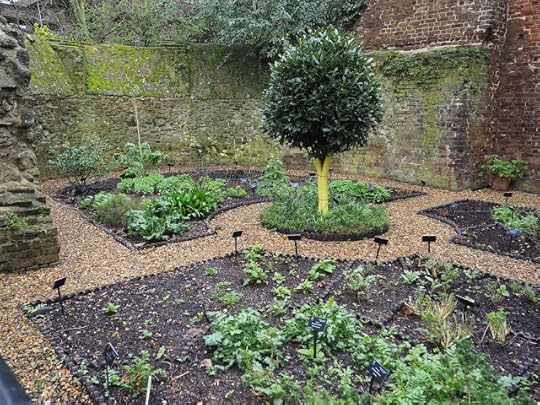
Rose Macaulay is best known in many quarters for the novel The Towers of Trebizon which I admit I haven’t read. I know her best for the book Pleasure of Ruins, a title I can never quite get right; I always think it should be Pleasures of Ruin, and I tend to put in a superfluous definite article or two.

The version I like best is the edition with photographs by Canadian Roloff Beny. He does have a few photographs of British ruins but none in London.
Our walk was a very fine walk, taking two hours or so, andof course serendipity always plays a part in these things. I wasn’t entirely surprised to see a Nicholson, because they get everywhere
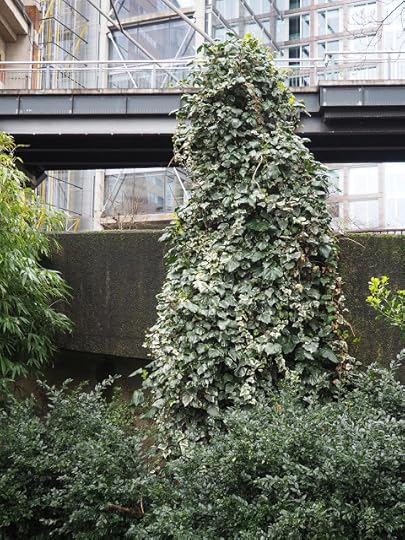
But I really wasn’t expecting Monkwell Square, a place I’d been to before, to be the scene if such hot, compelling obelisk action. OK, I accept that not everybody feels the same way about obelisks as I do.
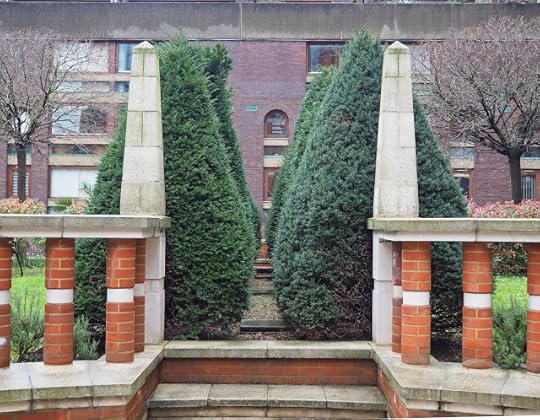
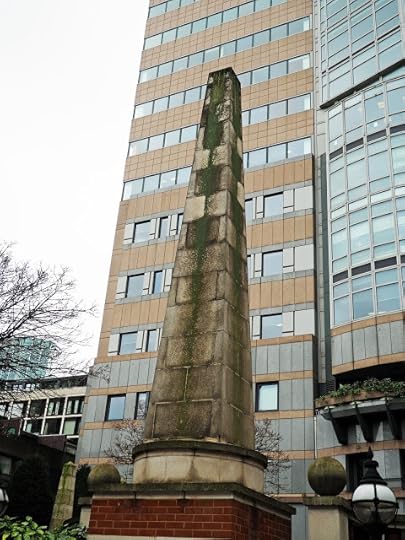
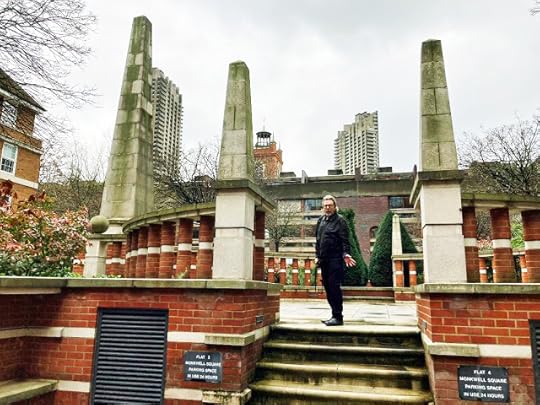 PHOTO BY CAROLINE GANNON
PHOTO BY CAROLINE GANNONMarch 11, 2024
DAY TRIPS WITH DAPHNE
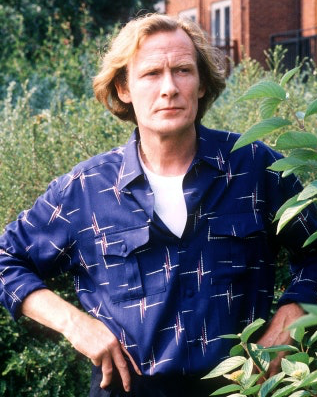
One of my infinitely minor claims to fame is that I was once, in some sense, “portrayed” on radio by Bill Nighty. He read my book first-person travel book Day Trips to the Desert on BBC Radio 4. Bill NIghy doesn’t sound remotely like me and yet I thought he got the tone of my “voice” and of the book, exactly right.
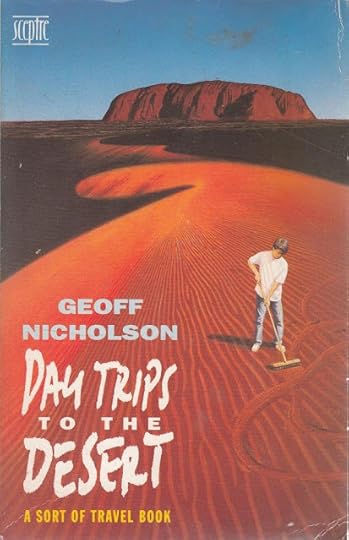
I met him very, very briefly in a studio in Broadcasting House and he was entirely the Bill Nighy you would want him to be.
Day Trips to the Desert isn’t exactly a walking book (whatever the heck that is) but there’s a reasonable amount of walking in it, walking that I did in Australia, the United States, Morocco and Egypt.
I can’t say how much of a walker Bill Nighy is but there are quite a few online pictures of him walking, such as this one in which he’s carrying a jar or Marmite, no I don't know why.

And sometimes he’s seen, in a professional capacity, with Helena Bonham Carter:

Just last week the two of them were on the radio performing a play titled
Beside Myself, with Bonham Carter as Daphne du Maurier and Nighy as “man”. To quote the publicity materials, the play allows the listener to “follow Du Maurier as she starts a conversation with a stranger while on an amble.”
Yes really, an amble!
“When a stranger approaches, Daphne … picks up her stiff stride, eager to get away. However, this one’s not to be deterred. As they walk along Daphne, to her own amazement, finds herself revealing much to the man about her life. Why is she compelled to divulge so much? Perhaps too much.”
This is Daphne du Maurier:

And this is Helena Bonham Carter, not walking.

She seems to be divulging quite a lot, but not too much, I’d say.
March 6, 2024
METHODICAL WALKING

If you find yourself at London’s Temple tube station there’s every reason to follow the signs and walk up a set of steps to the Artist’s Garden which is ‘an open-air public space for art by women artists.’ So maybe it should be 'Artists' Garden'? It’s actually on top of the station building itself; a roof terrace or I suppose roof garden. It’s surprisingly big, 1400 square metres. I mean it’s not like walking around Versailles but it’s definitely a place you can wander.
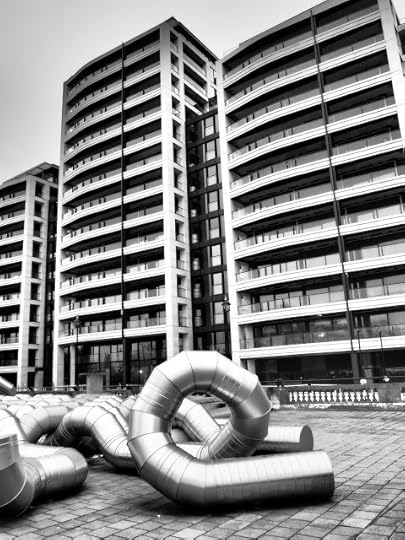
The current exhibition is by Holly Hendry and titled Slackwater, a sprawling installation chiefly made of industrial ducting. The contrast of the curved shiny metal of the art with the solid straight masonry of the buildings behind it, is spectacular, and of course on the other side you have the Thames.
There was also this by Annabel Tennyson-Davies who’s artist in residence at the garden.
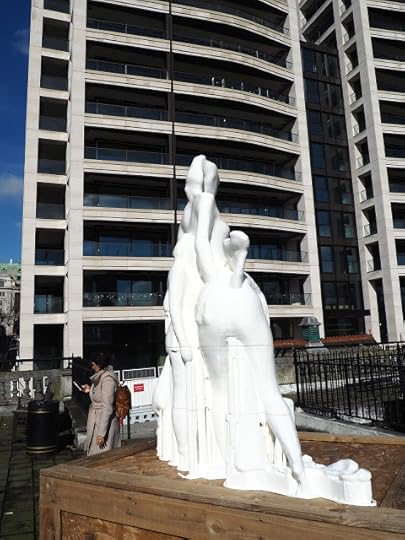
I’ve been up there once or twice and it’s never been busy with people, although I did see one visitor who’d found it a great place to have a kip.
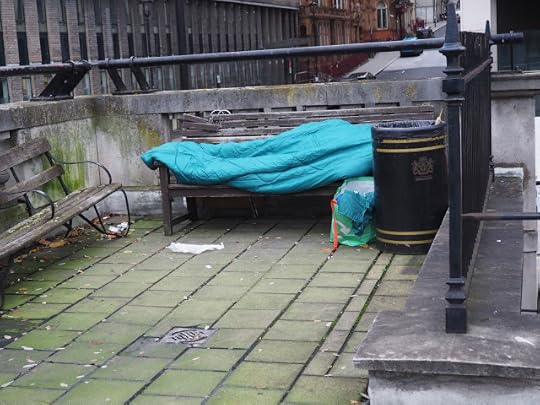
If you walk down the stairs when you’re finished you can then go into what you might call the non-artists' garden, or in fact the Victoria Embankment Garden, with a sign directing you to the Middle Temple Gardens, the end point of the City of Westminster Fitness Route, which is apparently a thing, though when you think about it, isn’t the whole world a fitness route if you want it to be?
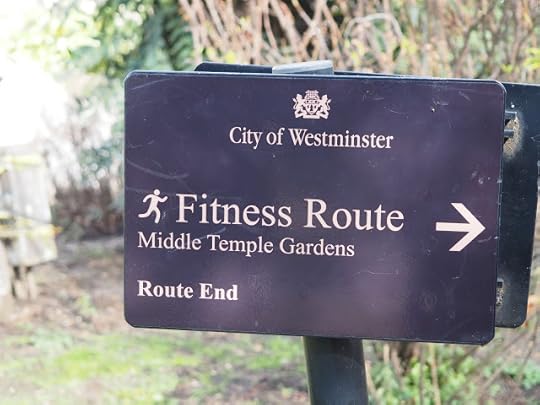

In fact I was only in those parts because I was on the way to see a ‘site specific and participatory installation’ by Zheng Bo in the center of the Somerset House courtyard.
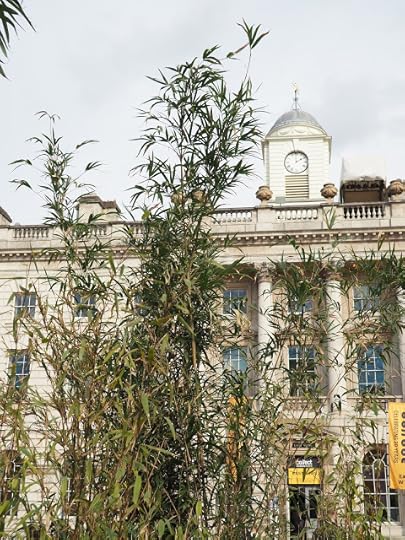
The artwork’s title was ‘Bamboo as Method’ which according to the online artspeak ‘pays homage to the Ming Dynasty thinker and scholar, Wang Yangming. Wang’s pursuit of enlightenment through the practice of gewu zhizhi (the acquisition of knowledge through the investigation of the nature of things) is encapsulated in Zheng Bo’s profound reference.’ There’s also a board up in the courtyard telling visitors that Zheng Bo is ‘eco-queer.’
But none of that was obvious from seeing the work itself. In fact it looked as though Mr. Bo had done a tour of quite a few garden centres, bought up all their bamboo and arranged it in planters to provide what was really a very interesting environment in which to walk.
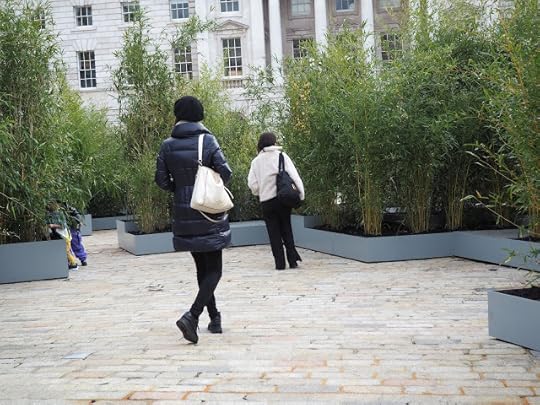
I like bamboo a lot ,without being any kind of expert, but I understand there are over 1,400 known species in 115 genera. Zheng Bo had managed to round up 10 different types.
The participation wasn’t the walking, or even the looking, but visitors were invited to draw the bamboo, or I suppose draw anything else they fancied, - pencils and paper were provided – and then drop the result in a box.
But one participant hadn’t made a drawing. He or she had made a paper plane and dropped it on the ground. Of course I found myself thinking about Harry Smith, the avant-garde filmmaker anthropologist, and collector of ‘lost’ paper planes.

As discussed elsewhere in this blog Harry Smith used to walk the streets of Manhattan in the late 60s to early 80s, finding discarded paper planes wherever he went, picking them up, then annotating and cataloguing them to form a ‘proper’ anthropological collection.
But this was the first time I can ever recall seeing a paper airplane lying on the ground when I was walking. Obviously I swooped on it. Do I feel an anthropological collection coming on? No, but the plane has gone straight into the archive of ‘things found while walking,’ which is a form of participation.
February 28, 2024
WALKING AS ART SUBJECT AND ART OBJECT
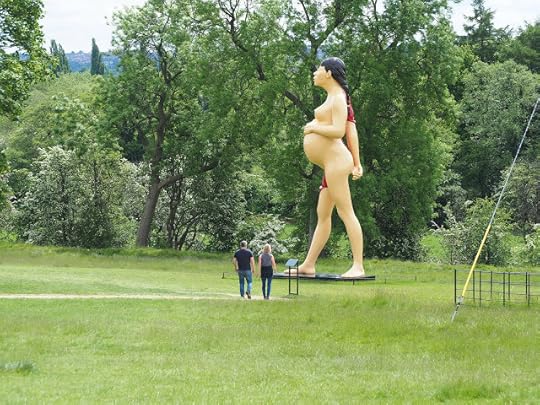
As a person walks through the world he or she inevitably sees other people walking through the world, and it seems that lots of people have decided this is a suitable subject for art.
More often than you might imagine, you see sculptures of people walking through the world. This is Brancusi’s Walking Man:
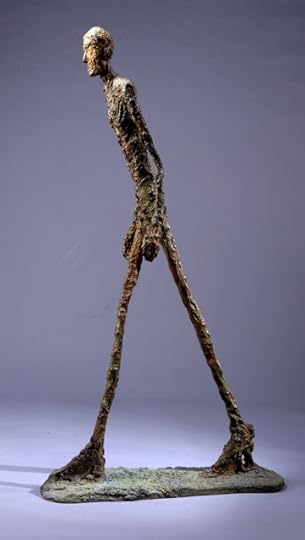
You would have to say that Brancusi walked the walk as well as made the art. In 1903 and 1904 he walked from Bucharest to Paris – Peter made a film about it, Walking To Paris.
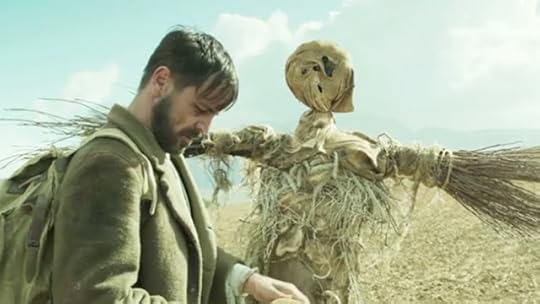
Of course there are walking women too, though not as many as we might like, including this one by Giacometti, Walking Woman1:
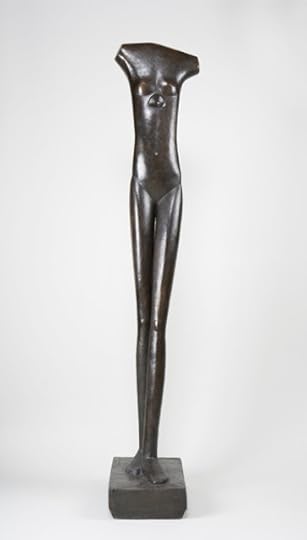
You’re unlikely to walking along and suddenly come upon a work by Brancusi or Giacometti – for that you probably need to be in an art gallery or sculpture park - but I realized that in my walking, without actively looking for them, I’ve come across quite a few of sculptures of walkers.
Not so long ago, walking in Holland Park I came across this by Sean Henry, titled Walking Man. The statue is painted bronze but the path he’s walking on is genuine concrete:

And I was reminded of the Walking Manin Sheffield by George Fullard, which I know fairly well, being a deracinated Sheffielder. It’s positioned outside what is now called the Winter Garden. I feel that most Sheffield walkers aren’t quite as lean as that statue – but let’s call it artistic license.
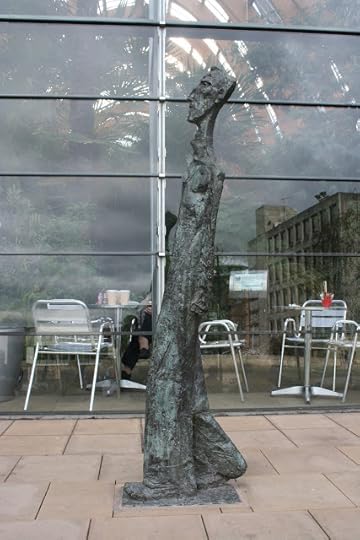
Naturally there are some interesting ironies in all this. The viewer is walking but even though the statue shows somebody walking they’re perfectly still, frozen in a moment. And sometimes of course the human walker stops to admire the stopped walking statue. As in this statue by George Segal, titled Walking Man which is at the (wait for it) Walker Art Center in Minneapolis.

And then it clicked that Sean Henry, the artist who made the walking man in Park Holland was also responsible for this Walking Woman in Colchester, who’s a favourite of mine.
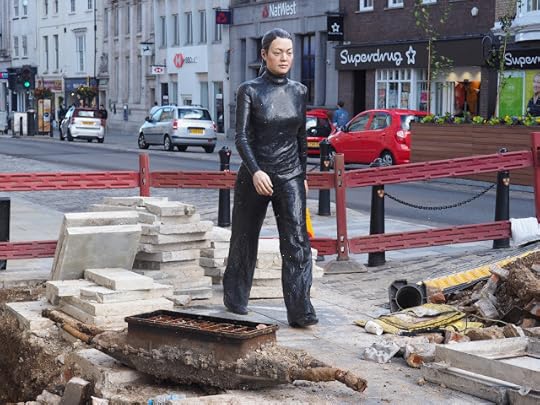
Apparently there are different versions of Sean Henry’s woman, placed in different locations, often in snowy climes. Frankly she doesn’t really look quite dressed for it.
And then there’s this fellow by Toni Matelli, titled Sleepwalker,who was in Regent’s Park for Frieze Sculpture 2023, who doesn’t seem to be dressed for anything at all.

Geoff Nicholson's Blog
- Geoff Nicholson's profile
- 55 followers



